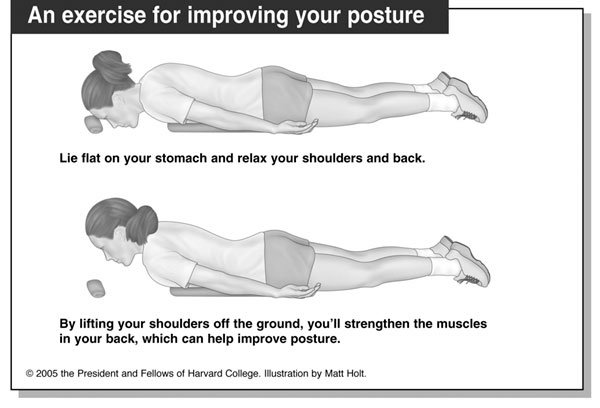Q: I’ve become slightly shorter, and more hunched over, as I’ve
gotten older. Are there ways to stop this trend?
A: Starting at about age 40, people typically lose half an inch
per decade. The decline increases after the 70th birthday.
By The Faculty of Harvard Medical School
Q: I’ve become slightly shorter, and more hunched over, as I’ve gotten older. Are there ways to stop this trend?
A: Starting at about age 40, people typically lose half an inch per decade. The decline increases after the 70th birthday. As we age, our bones become less dense, more brittle and, therefore, likelier to fracture. This loss of bone tissue is called osteoporosis, which is more common in women than men.
Usually, people think of a broken hip or wrist when they think of osteoporosis. But the knobby bones that make up our spine, called vertebrae, can also break. Instead of cracking, however, the bone crumples like a cardboard box that has had too much weight put on it.
When just one side of the vertebra collapses, it’s called a wedge fracture. These fractures occur most often in the vertebrae in the top part of the spine, between the bottom of your neck and the upper part of the small of your back.
Sometimes, the whole vertebra gives way. This type of fracture occurs most often in the lower spine, near the forward curve of the small of your back.
Most of these vertebral fractures don’t cause any pain or other symptoms, and are discovered by accident in a chest or abdominal X-ray.
Even a mild stoop in middle age may be a sign of vertebral fractures. A bad one in older age almost certainly is. A prominent hump in the upper back (insensitively nicknamed a widow’s, or dowager’s, hump) is usually the result of wedge fractures in the upper spine.
But some research suggests that vertebral fractures have been overrated as a cause of height loss and hunching. Another big reason may simply be bad posture.
For some, bad posture stems from a tendency to slouch during the teenage years that simply never went away. And if you spend a lot of time in front of a computer, you may notice how your back bends toward the video monitor and your shoulders roll forward, causing a hunched position.
Like all muscles, back muscles become weaker simply because of age. Once bad posture becomes a habit, ligaments get stretched and muscles get trained to be in a bent-over position. Flabby abdominal muscles don’t help. Hard “abs” can help your posture by counteracting tired back muscles.
But you can do some simple exercises that will strengthen certain back muscles so you can stand up a bit straighter. One of the best involves lying on your stomach and then lifting your head and shoulders for several seconds (see graphic). Slightly more strenuous is the “Superman” version that involves stretching your arms out in front of you instead of keeping them at your side. Sit-ups or crunches (a modified sit-up that involves contracting your stomach muscles) will strengthen your abdomen.
For overall muscle control, as well as posture and balance improvement, many people swear by yoga or tai chi, a form of Chinese martial arts that has been described as moving yoga.
You can do these preventive exercises on your own if you’re healthy. A little willpower, not a prescription, is all that’s needed to get started. But if you’re older, have osteoporosis, or both, talk to a doctor before you get started on an exercise program. The wrong exercises could do more harm than good.
Researchers at the Mayo Clinic have experimented with a device that looks like a little backpack. Small weights inside are supposed to pull people back a little bit, improving their balance and counteracting their hunched-over posture. Although they may sound simple enough, these devices shouldn’t be purchased over the counter.
Submit questions to the Harvard Medical School Adviser at www.health.harvard.edu/adviser. Unfortunately, personal responses are not possible.













